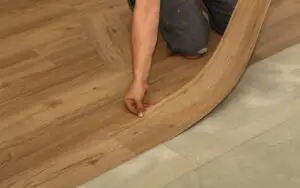Understanding Flooring Layers
What are Flooring Layers?
Subfloor
The subfloor is the structural base of your flooring system, and is typically made of plywood or concrete. It provides the foundation for all of the other layers, and must be structurally sound, level, and free of any moisture issues. Proper subfloor preparation is essential for all flooring projects, and is a very important first step to a long-lasting, and durable floor. Professional installers will always begin any project with a thorough inspection of the subfloor.
Underlayment
The underlayment is a layer that is installed on top of the subfloor. Underlayment will provide cushioning, moisture protection, sound insulation, and will also help to even out any minor imperfections in the subfloor. The type of underlayment used will vary depending on the type of flooring being installed, which is why professional installers often use different materials for different types of flooring.
Finish Flooring
The finish flooring is the top layer of your flooring system, and is the visible surface that you see and walk on. This layer is the material you have chosen, such as hardwood, tile, vinyl, carpet, or any other type of flooring. Proper selection, and installation of this top layer, is essential for the longevity, and the overall beauty of your finished project.
Why Proper Layering is Important
Stability and Support
Proper layering provides stability and support to the entire flooring system. The subfloor provides the base, the underlayment provides a stable and level surface, and the finish flooring provides the wear layer. When all layers are working in conjunction, they provide the best overall results for the floors in your home or business. Professional installers know how to layer the different materials to create the most durable and long lasting floor.
Moisture Protection
Proper layering also provides essential moisture protection, and prevents moisture from seeping into your subfloor, which can often lead to mold, mildew, and other issues. Underlayment with moisture barriers can help prevent moisture damage, and extend the life of your floors. This is why it is so important to choose a professional installer, that understands the different types of underlayment, and how they work to protect your floors.
Sound Insulation
Proper layering also provides effective sound insulation. Underlayment with sound absorbing properties can help reduce noise transfer, making your home quieter, and more peaceful. This is especially important in multi-story homes, or apartment buildings. Professional installers will always be aware of these types of concerns, and will offer solutions to help with sound absorption.
The Ideal Number of Flooring Layers
Recommended Layering for Different Flooring Types
Hardwood Flooring
For hardwood flooring, the ideal layering typically includes a subfloor, an underlayment, and the hardwood flooring itself. The underlayment will provide a moisture barrier, and it will help to even out any minor imperfections in the subfloor, while also providing an extra level of stability and sound absorption. Professional installers will always follow industry best practices when installing hardwood flooring.
Tile Flooring
For tile flooring, the ideal layering typically includes a subfloor, a layer of cement board, a layer of thinset mortar, and then the tile. The cement board provides a stable and moisture resistant base, and the thinset mortar will provide a strong adhesive bond. This layering method is critical for a successful tile installation, and professional installers are experts in all of these procedures.
Vinyl Flooring
For vinyl flooring, the ideal layering often includes a subfloor, an underlayment, and the vinyl flooring. If the subfloor is not smooth, or has any imperfections, a leveling compound may be required, before installing any underlayment or finish flooring. Professional installers can assess the subfloor and provide all of the necessary steps to ensure a smooth and even base for your new vinyl flooring.
Carpet Flooring
For carpet flooring, the ideal layering typically includes a subfloor, carpet padding, and the carpet. The carpet padding will provide cushioning, sound insulation, and will also help to extend the life of the carpet. It is also essential that the carpet pad is properly installed, to ensure that the carpet will be installed correctly and will also last for as long as possible. Professional installers will always use best practices to ensure that your new carpet is installed with maximum durability.
When to Avoid Multiple Layers
Issues with Height
Adding too many layers of flooring can lead to issues with height, especially when transitioning to other types of flooring. When floors are too high, it can create a trip hazard, and it can also make it very difficult to close doors. These problems are easily avoided when you use a professional flooring installer.
Inadequate Support
Too many layers can also lead to inadequate support, especially if the subfloor is not level, or if the materials being used are not compatible with each other. Improper layering can cause uneven surfaces, and can also increase the chances of the floor buckling or collapsing. Professional installers are very skilled in all of these areas, and know how to make sure all layers work together in harmony.
Potential Damage
Too many layers can also trap moisture, and can lead to potential damage to the subfloor, and other building materials, by creating an environment that fosters mold and mildew growth. These types of issues can also affect the overall health, and well being, of those that occupy the space, and can also create costly repairs and health problems down the road.
Potential Problems with Multiple Layers
Height and Transition Issues
Door Clearance
Too many layers can create door clearance issues, making it difficult, or even impossible to open and close doors, which can be very frustrating, and an unnecessary headache. Proper planning will always help avoid these issues, and professional installers are experts in planning and preventing all of these common problems.
Uneven Transitions
Multiple layers can also cause uneven transitions between rooms, which will not only look unprofessional, but may also create a safety hazard. These types of issues are easily avoided when the job is completed by a professional installer who uses best practices, and is aware of all of the potential problems that can arise when using multiple layers of flooring.
Stability and Support Problems
Lack of Proper Support
Too many layers of flooring can lead to a lack of proper support for the top layer, which can result in shifting, flexing, or damage to the flooring. It is essential that all layers are installed correctly, and that they all work together in harmony, to ensure a stable, and durable floor. This is why it is always important to hire a professional installer, who is well aware of all of the importance of proper support for all flooring projects.
Increased Risk of Damage
Improper layering can also increase the risk of damage, to the floors. Shifting, and flexing, can cause premature wear, scratches, and other types of damage to your floors, and these types of issues will often require costly repairs, or replacements. Professional installers are trained to ensure these types of issues will never happen.
Moisture and Mold Issues
Trapped Moisture
Too many layers of flooring can trap moisture between the layers, which can lead to several problems. Trapped moisture will lead to mold and mildew growth, which can have several negative health effects, and can also damage your floors, and require expensive repairs. Professional installers are always trained to take every precaution to avoid these types of problems.
Potential for Mold Growth
The potential for mold growth, is one of the most significant problems when using too many layers of flooring. Trapped moisture, combined with organic material in the under layers, creates the perfect breeding ground for mold and mildew. Mold can not only damage your floors, but can also cause many respiratory problems and health concerns. Proper layering is essential to protect from all of these issues, and is always performed correctly by professional installers.
Professional Advice on Flooring Layers
Proper Subfloor Preparation
Importance of Leveling
Proper leveling of the subfloor is crucial before installing any type of flooring, and will often be the first step of all flooring projects that are performed by a professional installer. If the subfloor is uneven, it can cause problems such as an uneven surface, flexing, and a shorter lifespan for the flooring. Leveling the subfloor is always the first step to creating a stable, long lasting, and beautiful floor.
Addressing Moisture Issues
Addressing moisture issues before any flooring is installed is absolutely essential to the success of all flooring projects. Moisture can come from many different sources, such as leaking pipes, high humidity levels, and even water that is tracked in from outside. Identifying and addressing any moisture issues early on is the best way to prevent problems in the future. Professional installers are well versed in identifying and addressing all types of moisture issues.
Benefits of Professional Installation
Correct Layering Techniques
Professional installers have all of the knowledge, skills, and tools needed to ensure proper layering techniques, and they always follow all of the industry best practices for every type of flooring material. They are also familiar with all of the potential problems that can occur with improper layering techniques, and they always use their knowledge to ensure the best possible outcome, and the longest lasting and most durable results.
Expertise and Experience
Professional installers bring expertise and experience to your flooring project. They have completed many projects, and have seen all of the common problems that can arise, and they will always be ready to offer solutions that meet your specific needs, and budget. This experience is essential for completing a successful project.
DIY vs Professional Flooring Installation
Challenges of DIY Layering
Mistakes and Rework
DIY flooring layering projects often come with many challenges, such as the potential for costly mistakes, and the need for extensive rework. Improper layering will often lead to an uneven surface, or to other types of issues that may require expensive repairs. This is why most homeowners choose professional installers, who can guarantee the quality of their work, and offer a warranty to protect your investment.
Lack of Expertise
DIY projects also lack the necessary expertise and experience needed for a successful flooring installation. Professional installers have all of the knowledge, and skills, to properly prepare the subfloor, select the correct materials, and to ensure a durable, and long lasting floor. This type of expertise is hard to come by, and is essential for all flooring projects.
Advantages of Professional Layering
Guaranteed Results
Professional installers always guarantee their work, and they always provide the highest quality results, ensuring that your new flooring will be both durable, and long lasting. This level of assurance is not available with DIY projects, which is why most homeowners will choose a professional installer, and avoid the risk of a DIY project.
Warranty and Protection
Professional installers often provide warranties that cover the labor, and materials that were used in the project, giving you a great deal of protection and peace of mind. Most DIY projects, never offer any type of warranty, and all of the risks and liabilities are entirely on the homeowner, which is why a professional installer is always a better option for most homeowners.
Case Studies: Layering Mistakes
Example of an Unstable Floor from Improper Layering
A homeowner attempted a DIY flooring installation by layering new flooring over an old, uneven subfloor. The multiple layers led to an unstable floor, which buckled, and made it difficult to walk on, and it also created a trip hazard. This homeowner then had to hire a professional to remove all of the flooring, and to redo the project correctly, which ended up costing much more than if they had just hired a professional in the first place.
Example of a Successful Professional Install
Another homeowner hired a professional installer for their flooring project. The professional installer carefully prepared the subfloor, selected the correct underlayment, and installed the new flooring correctly, with a focus on best practices and techniques that ensured a smooth and even floor, that was built to last. The homeowner was extremely pleased with the high-quality results, and the peace of mind that they received, knowing that their floors would last for many years to come.
FAQs & Answers
A typical flooring system usually includes three layers: the subfloor, the underlayment, and the finish flooring. The subfloor provides the structural base, the underlayment offers cushioning, moisture protection, and sound insulation, and the finish flooring provides the visible surface. Professional flooring installers understand that proper layering is essential for a stable, durable, and long-lasting floor.
While it’s often not recommended, in some rare situations, you might be able to install new flooring over old flooring, as long as the old flooring is in good condition, is level, and provides a stable base. However, this practice can often lead to many issues, and is not recommended in most situations. Professional installers can assess your specific situation and advise you on the best approach for your unique needs.
Having too many layers of flooring can create a variety of problems, such as issues with height, uneven transitions, inadequate support, and increased risk of damage, and is never recommended by a professional installer. It can also trap moisture, which can lead to mold and mildew. Because of all of these potential issues, it is always best to start with a proper subfloor, instead of attempting to layer new flooring on top of old flooring.
Professional flooring installers follow strict guidelines and best practices for proper layering techniques. They will always begin with a proper inspection of your subfloor, and prepare the subfloor as needed, before laying the correct type of underlayment, and then installing your new flooring using the best techniques and materials. This process ensures that the finished flooring is both durable and stable.
Professional flooring installation services often offer warranties that cover the labor, materials, and methods used during installation. These warranties ensure that if any problems arise from the installation, the installer will address them without any additional cost to you. This is a very important benefit that DIY jobs do not provide, and it helps give you complete peace of mind.





